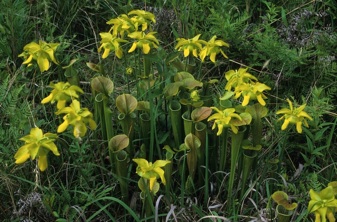Committee Members:
Patrick Thompson (chair): Auburn University Davis ArboretumContact Point:
Patrick Thompson, Davis Arboretum.Project Rationale: Sarracenia oreophila was listed by the USFWS on September 21, 1979. It is restricted to areas of the Cumberland Plateau and Ridge and Valley provinces in northeast Alabama, northwest Georgia and far western North Carolina. In 1994, the year of the most recent recovery plan, only “35 sites” were known. Population sizes ranged from “one to several thousand plants with estimates based on counts of discernable clump of plants.” Since most of the surrounding mixed-mesophytic forest/oak hickory forest have been cleared for lumber or agricultural purposes, most (if not all) populations occur in modified environments where they prefer moist to boggy acidic soils or sandy stream banks.
“Poor site conditions and lack of seedling recruitment areas may be a factor to the lack of seedling recruitment.” However, rhizomes are long-lived and asexual reproduction via rhizomes is the principle mode of reproduction observed in some populations. Our committee is connected with efforts to bolster populations primarily on private and state lands. Most populations would benefit from additional management efforts.
Short-term Goals:
1. Remove trees to increase light to natural population at Desoto State Park
2. Monitor a new subpopulation for seed production and safeguarding
3. Monitor seed poaching and consider implementing video surveillance or other security measures at affected sites
Long-term Goals:
1. Meet recovery criteria for downlisting or delisting under the Federal Endangered Species Act
2. Augment existing populations
3. Manage existing sites
4. Monitor existing populations
Accomplishments:
1. New subpopulation brought into safeguarding at AU Davis Arboretum and Atlanta Botanical Gardens
2. High success rate with seed propagation on state lands
3. Education campaign by Desoto State Park
4. Detailed mapping of some Alabama populations
5. Establishment of in situ safeguarding population on protected land

